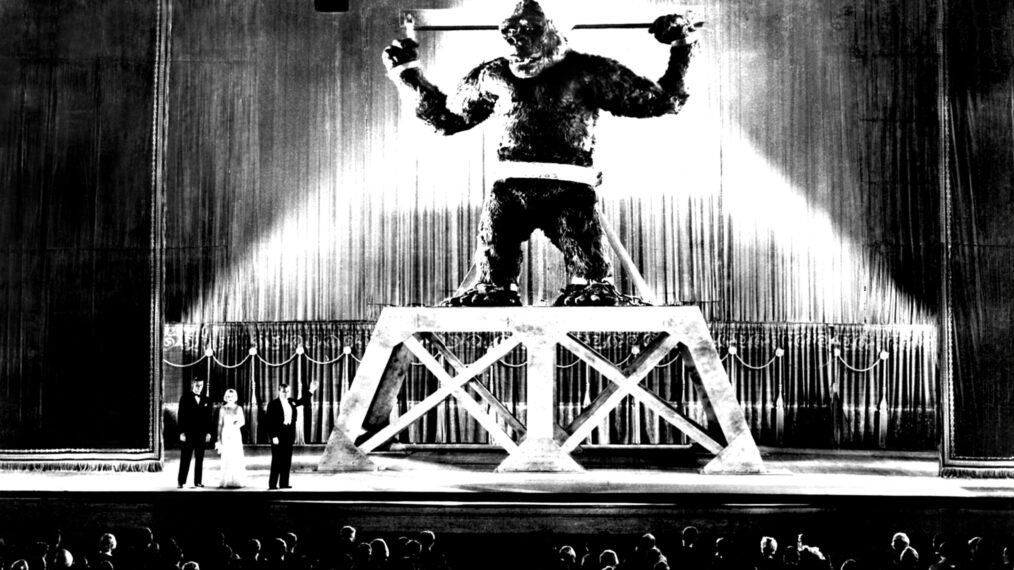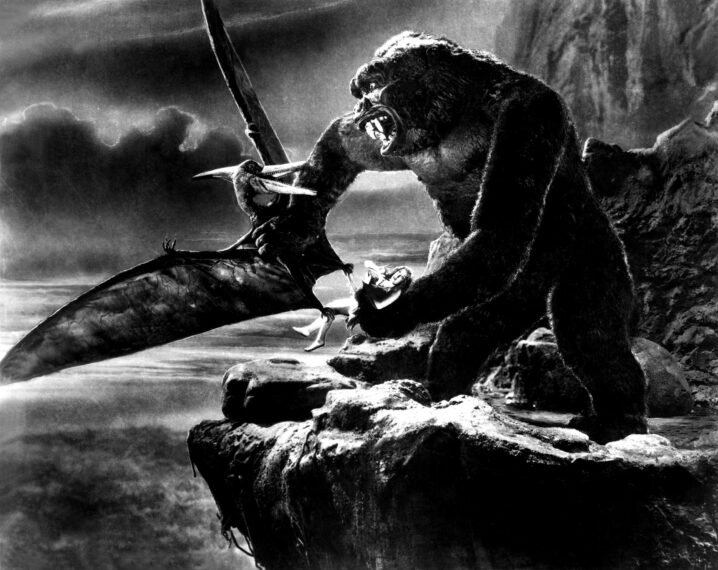After 90 Years, ‘King Kong’ Is Still a Wonder

Happy 90th anniversary to cinema’s greatest ape!
On March 2, 1933, the original King Kong was released by RKO. While it is not technically the first film in the “giant monster on the loose” genre (that distinction falls to the 1925 silent film The Lost World, which culminates with a brontosaurus rampaging through London), it is certainly among the most influential. Not merely a terrific creature feature, King Kong is a breathtaking adventure film that remains as fun and exciting as ever after nearly a century, despite its lack of the computer-generated enhancements that highlight modern movies (including the ape’s recent big-screen incarnation in Godzilla vs. Kong).

Kong battling one of the other monstrous inhabitants of Skull Island in 1933’s King Kong (Everett Collection)
Of course, a large part of the film’s success is due to the technical wizardry of Willis H. O’Brien. O’Brien had already pioneered stop-motion effects in the aforementioned The Lost World, and really upped the game in King Kong with painstakingly crafted visual effects that bring the title creature and the other monstrous inhabitants of Skull Island (including another brontosaurus) to thrilling life — and in sometimes truly terrifying ways that may have only seen the screen due to the fact that the production was made in the pre-Code era.
There are horrifying scenes of the giant ape stepping on people, and Kong and dinosaurs chewing people, while Kong’s famous battle with a T. rex ends in a particularly brutal and graphic way that might not have been allowed by censors even just a few years later. One scene, the infamous Spider Pit sequence, was reportedly too horrific to include even in a pre-Code movie, when the ape shakes men off a log into a chasm, where they are devoured by giant insects and spiders (Peter Jackson did reimagine this sequence in his 2005 Kong remake).
O’Brien’s effects in Kong go further than those in his earlier film beyond just their technical improvements; they also manage to give the film’s gigantic primate protagonist a soulfulness in certain scenes.
Given that, you can’t help but feel for Kong when he is taken from his jungle home, or even when he goes on a rampage in the urban jungle of New York City, eventually making his iconic and tragic visit to the Empire State Building with Fay Wray in hand. The creature has joined the small ranks of famous movie monsters (I would also include Frankenstein’s creation and the Gill-Man in this mix) who can make you feel empathy for their plight even as they might also horrify you.
I would also attribute King Kong’s enduring success to the musical contributions from Max Steiner. The score for the film was the legendary composer’s breakthrough (and he, of course, went on to score other classics, like Casablanca, Now, Voyager and A Summer Place), and is incredibly exciting to listen to, even removed from the visuals of the movie.
Speaking of elements of King Kong’s sound, Fay Wray’s screams have to be singled out. Given the era in which this film was made, along with the racist depictions of Skull Island’s natives and the Venture‘s Chinese cook, there is also a sexist handling of Wray’s character, Ann Darrow, who isn’t given too much to do beyond ending up in helpless situations and screaming. A lot.
To be fair, that’s what I would also be doing if a gigantic ape kept grabbing me and violently dispatching prehistoric beasts in epic battles all around me, or carrying me to the top of the world’s tallest building, and Ann is a lot more interesting than the hero who keeps saving her, Jack Driscoll (Bruce Cabot), who is kind of a dud, if we’re being honest. Wray’s shrieks are pretty iconic, and she ranks as one of the first, and greatest, of Hollywood’s “scream queens.”
Demonstrating that Hollywood’s desire to follow up one successful vehicle with another is not a recent thing, RKO quickly produced and released a sequel to King Kong — very quickly; that next film, Son of Kong, premiered Dec. 22, 1933, just a little over nine months after the original hit theaters. It brought back Robert Armstrong as Carl Denham, with O’Brien again on visual effects. The film takes a more humorous tone (in some scenes, “Little Kong” kind of reminds me of the Bumble in Rudolph the Red-Nosed Reindeer), and has some fun moments, particularly a scene involving a styracosaurus (as a big dinosaur nut in my childhood, I was always excited to see movies like this that used less-obvious dinosaurs) but overall the production, even O’Brien’s effects to a degree, feels as rushed as I’m sure it probably was by the studio, and doesn’t pack the same wallop as the first film.
Strangely, King Kong was not nominated for any Oscars, even for its visual effects. O’Brien did get a little vindication 16 years later, though, with his work on another classic film involving a massive ape: 1949’s Mighty Joe Young. Overseeing various technical aspects of the production (with the brunt of the special effects animation done by a young assistant named Ray Harryhausen, who would become a groundbreaking VFX artist in his own right), O’Brien was handed the Oscar for Best Special Effects by producer Merian C. Cooper, who had also produced and codirected King Kong, acknowledging O’Brien’s achievements on both films.
Despite any Academy Award slights at its time, King Kong has more than stood the test of time as not only a thrilling, and sometimes horrifying, adventure tale, but also as a groundbreaking technical achievement in film history. Kong himself, paraded in chains in front of New Yorkers near the movie’s climax, is billed as “The Eighth Wonder of the World,” and his film remains a wonder in its own right. As enjoyable as the remakes of this film, or different incarnations of the title character in other movies, over the decades may be, the 1933 original remains the king of Kongs.
